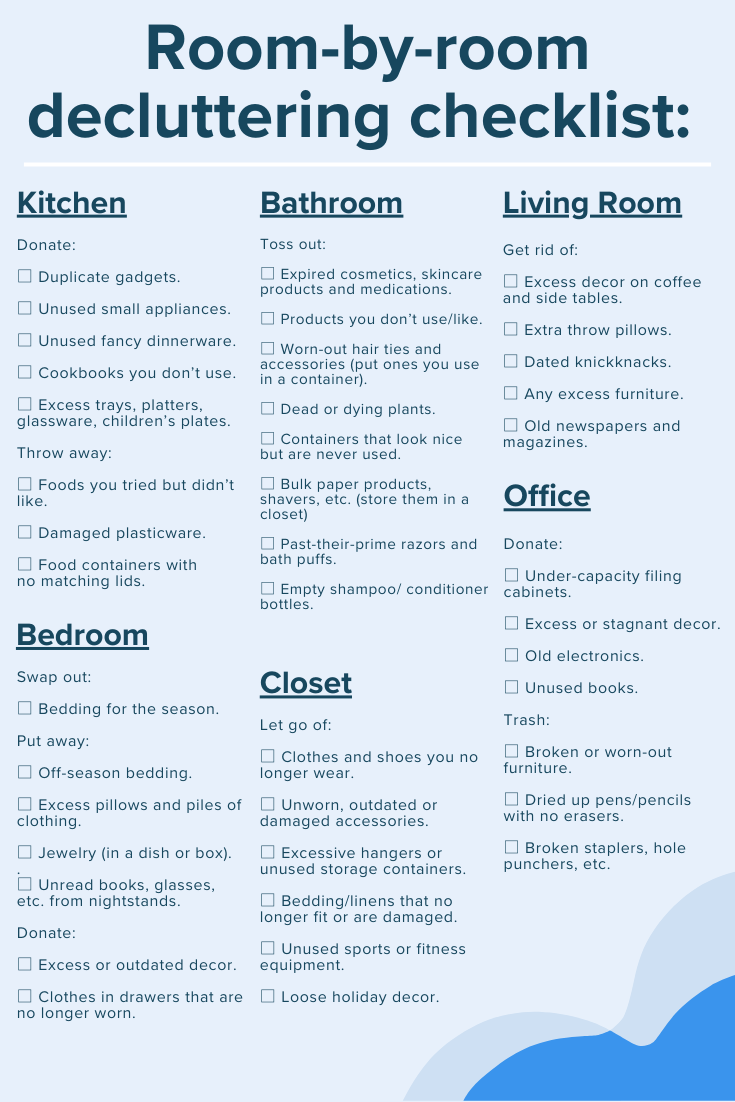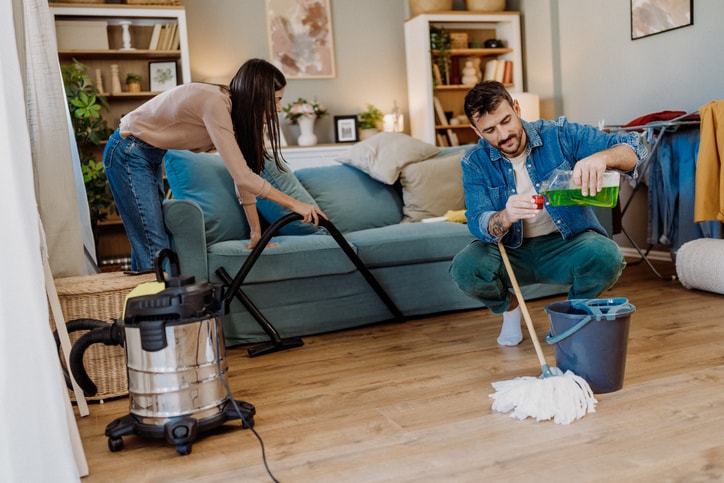It happens to the most fastidious of folks. The mail doesn’t get opened for a few days, clothes pile up on a chair, knickknacks and trinkets never find a home (parents, you surely understand…) and before you know it, the house is cluttered and you can’t think straight and you’re not even sure why.
“A clutter-free space isn’t just about aesthetics. It’s about creating a home where you and your family can thrive,” explains Aaron Traub, owner of My Professional Organizer Dallas. “When your home is organized and decluttered, it removes the constant mental strain in the back of your head saying, ‘I need to get this done.’ Additionally, organized homes can improve focus, boost creativity and just make it a more enjoyable place for everyone to live.”
Want to purge, but don’t know where to start? Check out our expert-vetted decluttering checklist, which breaks down everything you or your house cleaner need to do, room by room.
“When your home is organized and decluttered, it removes the constant mental strain in the back of your head saying, ‘I need to get this done.’”
— Aaron Traub, owner, professional home organizing and decluttering company
Decluttering checklist
Ready to declutter? Here’s a room-by-room declutter checklist, per Traub, as well as Michelle Parravani, owner of Designing With Less in Atlanta; Maria Mooney, a nontoxic cleaning expert and marketing director at Truly Free Home; and Brenda Scott, a professional organizer and owner of Tidy My Space.
Use on your own or to share with house cleaners or housekeepers.
(Click to download this decluttering checklist as a PDF.)
Kitchen declutter checklist
The kitchen is a hotspot for clutter, and in a room where real estate is at a premium, it’s best to start big, notes Traub.
“Begin with unused pots, pans, utensils and expired food or spices,” he says. “These items take up valuable space and are often forgotten.”
Here’s what else you can get rid of:
- Duplicates (think: mixing spoons, spatulas, can openers, salad tongs, aprons, meat thermometers, mashers.)
- Broken gadgets.
- Unused small appliances
- Foods you tried but didn’t like.
- Unused, fancy dinnerware.
- Damaged plasticware.
- Plastic or glass food containers with no matching lids.
- Unused platters/trays, excess glassware, children’s plates.
- Piles of newspapers, magazines and cookbooks that don’t get used.
Living room declutter checklist
When it comes to the living room, think about visual clutter, says Mooney. “Take a look around and remove any unnecessary items,” she says.
Here’s what else to consider ditching:
- Extra throw pillows.
- Dated knickknacks.
- Any excess furniture.
- Old newspapers and magazines.
- Any unnecessary decor that takes up space on coffee and side tables.
Bedroom declutter checklist
Often rife with untidiness in a different way, bedrooms are also often a magnet for clutter. Here’s how to declutter bedrooms:
- Put excess pillows away or get rid of them.
- Put away piles of clothing that are on the floor or piled on chairs.
- Clear the nightstand of unread books, glasses, etc.
- Put jewelry in a jewelry dish or box.
- Replace small hampers with larger ones that can be carried to the laundry room.
- Ditch excess or outdated decor.
- Go through and donate clothes in drawers and closets that are no longer worn.
- Switch out bedding for the season, taking care to put away what you’re not using.
Bathroom declutter checklist
Do you always toss products when you’ve finished them? Didn’t think so. Here’s what to get rid of in the bathroom:
- Expired cosmetics, skincare products and medications. (Keep only what you use!)
- Bottles of products that you don’t use/like.
- Hair ties and hair accessories (put ones you use in a container).
- Excess decor, such as dead or dying plants, and containers that look nice but are never used.
- Bulk bundles of paper products/shavers/jumbo bottles or 2-for-1 products. (“These should go in a closet or only buy what fits in your space,” notes Mooney.)
- Past-their-prime razors and bath puffs.
- Empty shampoo/conditioner bottles in the shower.
Closet declutter checklist
When it comes to closets, the main focus, Traub notes, should be on clothes and shoes. “Donate or get rid of anything you no longer wear or that’s unrepairable,” he says. “If you haven’t worn it in a year, it’s time to let it go!”
Other things to get rid of in closets, include:
- Bedding/linens that no longer fit or are damaged.
- Sports or fitness equipment that’s no longer used.
- Loose holiday decor (“These should be contained with others and labeled,” says Mooney.)
- Excessive hangers or unused storage containers.
- Unworn, outdated or damaged accessories, such as old belts, scarves, etc.
Mooney also notes that folks should think twice before purchasing “excessive amounts of items that can be bought for under $20 easily. There’s no need to “stockpile toilet paper, tissues, paper towels, soap, etc.,” she says.
Garage declutter checklist
Let’s face it: Many items come to die in the garage. “The garage should be functional,” Traub notes, “not a catch-all for forgotten items.”
Here’s what Traub, Parravani and Mooney say to let go of:
- Rusty or broken tools (or anything that’s been waiting to be repaired for years).
- Unused sports equipment.
- Old cleaning products.
- Accessories for cars you no longer have.
- Broken or damaged ladders.
- Empty boxes.
- Paper piles.
- Unused seasonal decor.
- Old gardening supplies, such as expired fertilizers.
- Old paints and chemicals.
Office declutter checklist
The first thing to do when decluttering your office, according to Mooney, is to “say goodbye to the paper piles that have been haunting your desk, countertops and drawers.”
“Sort through old receipts, bills and documents, shredding what you no longer need and organizing the rest,” she continues. “A clutter-free workspace means a clear mind, and starting from scratch can often be the best approach to creating your cleanest workspace.”
Once papers are cleared, go through:
- Excess or stagnant decor.
- Old electronics.
- Broken or worn-out furniture.
- Under-capacity filing cabinets.
- Unused books.
- Dried up pens/pencils with no erasers.
- Broken staplers, hole punchers, etc.
Why is it important to declutter?
If you’re on the fence about getting started (who isn’t?), here are a few reasons to pick up some trash bags and bite the bullet:
It makes daily life smoother. When your space is free from piles of you-know-what, everything is just easier. “How many times are you running late but can’t seem to find your other shoe that happens to be buried in your closet?” notes Mooney. “No one has time for that.”
Cleaning is easier. It’s almost impossible to clean when there’s clutter, Mooney adds. (And decluttering is not a built-in task for cleaners, FYI.) “Cleaning a space is far less daunting when you remove all the clutter,” notes Mooney.
There’s more time for what you love. Decluttering is about carving out time for what truly matters — especially for busy parents, Mooney notes. “With the chaos under control, there’s more room for hobbies, reading or just enjoying your cup of tea in peace.”
Less stress. Research shows that clutter creates stress and anxiety. “It’s a visual reminder of something we haven’t done, so clearing clutter is like lifting a weight off your shoulders,” explains Parravani. “You can think more clearly without clutter around you, and you can break free from the shame that clutter creates.”
Further, she adds, clutter can be particularly stressful for parents and caregivers. “Being in a clutter-free space can be grounding and calming, which is important to everyone,” she says. “But it’s vital when so much of your energy is going to caring for others.
How to maintain a clutter-free homes
The best way to maintain a clutter-free home is to declutter regularly. This, according to Parravani, is called “micro-decluttering.”
“It’s less overwhelming than tackling everything at once,” she says. “You can make real progress by decluttering here and there, whether that’s every day, every week or even just once a month.”
Other approaches and tips:
Tackle clutter after every season. “For instance, during the summer, you might accumulate extra beach towels or outdoor toys,” explains Mooney. “When you take a moment to organize these items, consider what you can donate or discard to make space for what the next season requires. Store or donate excess beach towels at the end of summer to free up room for more winter blankets and coats.”
Start small. Don’t feel like you need to take on your entire home in one fell swoop, as they can make the task feel completely overwhelming. “Tackle one room, drawer or cabinet at a time,” notes Traub. “The key is to build momentum with small wins and use that energy to tackle other areas of the home.”
One in, one out. Buy something? Get rid of something. This is what Parravani calls the “one in, one out” rule. By doing this, you’re being more mindful of what you’re bringing into your home, while ensuring “stuff” doesn’t take over.
Buy less. Better yet, consider buying less overall. While it can be tricky with fickle and growing kids (along with relentless advertising and influencing), having the goal of a clutter-free home can boost your willpower when you feel the itch to buy something you may not need.
The bottom line
To be truly effective, decluttering needs to be a lifestyle, not just a once-a-year chore. “Making decluttering a habit can turn into a routine and then it no longer feels overwhelming or stressful,” Scott says. “The goal, ultimately, is to have control over your stuff, not the other way around.”




